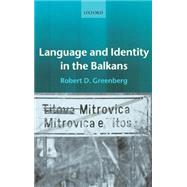
Note: Supplemental materials are not guaranteed with Rental or Used book purchases.
Purchase Benefits
Looking to rent a book? Rent Language and Identity in the Balkans Serbo-Croatian and Its Disintegration [ISBN: 9780199258154] for the semester, quarter, and short term or search our site for other textbooks by Greenberg, Robert D.. Renting a textbook can save you up to 90% from the cost of buying.
| Acknowledgements | ix | ||||
| 1 Introduction | 1 | (15) | |||
|
1 | (3) | |||
|
4 | (2) | |||
|
6 | (3) | |||
|
9 | (4) | |||
|
13 | (3) | |||
| 2 Serbo-Croatian: United or not we fall | 16 | (42) | |||
|
16 | (2) | |||
|
18 | (6) | |||
|
20 | (1) | |||
|
21 | (2) | |||
|
23 | (1) | |||
|
24 | (8) | |||
|
24 | (5) | |||
|
29 | (3) | |||
|
32 | (9) | |||
|
34 | (1) | |||
|
35 | (4) | |||
|
39 | (2) | |||
|
41 | (6) | |||
|
41 | (3) | |||
|
44 | (3) | |||
|
47 | (7) | |||
|
48 | (2) | |||
|
50 | (1) | |||
|
51 | (3) | |||
|
54 | (4) | |||
| 3 Serbian: Isn't my language your language? | 58 | (30) | |||
|
58 | (1) | |||
|
59 | (6) | |||
|
|||||
|
63 | (2) | |||
|
65 | (4) | |||
|
69 | (8) | |||
|
77 | (6) | |||
|
83 | (2) | |||
|
85 | (3) | |||
| 4 Montenegrin: A mountain out of a mole hill? | 88 | (21) | |||
|
88 | (3) | |||
|
91 | (6) | |||
|
92 | (2) | |||
|
94 | (3) | |||
|
97 | (5) | |||
|
98 | (1) | |||
|
99 | (3) | |||
|
102 | (3) | |||
|
103 | (1) | |||
|
104 | (1) | |||
|
105 | (4) | |||
| 5 Croatian: We are separate but equal twins | 109 | (26) | |||
|
109 | (2) | |||
|
111 | (7) | |||
|
111 | (4) | |||
|
115 | (3) | |||
|
118 | (7) | |||
|
120 | (2) | |||
|
122 | (3) | |||
|
125 | (7) | |||
|
125 | (3) | |||
|
128 | (4) | |||
|
132 | (3) | |||
| 6 Bosnian: A three-humped camel? | 135 | (24) | |||
|
135 | (2) | |||
|
137 | (2) | |||
|
139 | (3) | |||
|
142 | (8) | |||
|
143 | (3) | |||
|
146 | (4) | |||
|
150 | (5) | |||
|
155 | (1) | |||
|
156 | (3) | |||
| 7 Conclusion | 159 | (9) | |||
|
159 | (5) | |||
|
164 | (4) | |||
| Appendix A: Text of the 1850 Literary Agreement | 168 | (4) | |||
| Appendix B: Text of the 1954 Novi Sad Agreement | 172 | (3) | |||
| Works cited | 175 | (8) | |||
| Index | 183 |
The New copy of this book will include any supplemental materials advertised. Please check the title of the book to determine if it should include any access cards, study guides, lab manuals, CDs, etc.
The Used, Rental and eBook copies of this book are not guaranteed to include any supplemental materials. Typically, only the book itself is included. This is true even if the title states it includes any access cards, study guides, lab manuals, CDs, etc.